I finally managed to get some outdoor time (and come up with something to blog about). There are signs of spring already, although most of them are subtle, mostly auditory. The calls I hear when I step outside early in the morning are definitely about spring and territories.
Buffleheads are winter residents here, and haven’t started to move north yet (I usually don’t fly close enough to water to create that good a reflection) (as usual, click on the picture for a full-res version):

but Kingfishers and Mallards are here all year round:
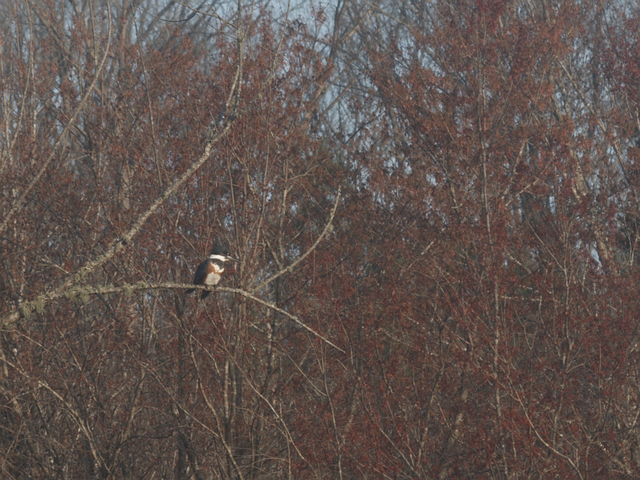

A Cormarant (ID based mainly on outline and beak shape) on early morning patrol:

I went down below the dam to look around and get a different prespective on the lake:

I spotted these Geese coming in low towards the dam, over wind-rippled water the same shade of blue as the clear sky…

…where they gathered, completely ignoring the signs that warn about people not being allowed on the dam:

That blue sky makes for blue water everywhere:
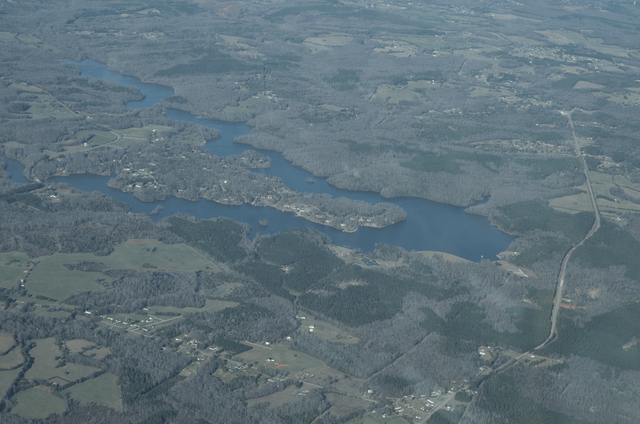
First winter storm of 2017
As often happens, this area is right where things change, and just a few miles can make a difference between the 4-6″ of snow in the counties to the north, and the dusting we got here in Laurens County.


Actually, I saw the first snowfall a week ago on December 31, 2016. We had to go to 9500′ over Oconee County to find it, but it was there, and it was falling, even if it wasn’t reaching the ground.
On helping
A friend sent me a story that got me thinking. I know, sometimes I just can’t help it. Warning: this is a bit of a rant.
As the story goes, a man was in a hurry to get through a supermarket line because he was on his lunch break and didn’t have much time. People weren’t too enthusiastic about letting him go ahead, but were curious why he was buying all these toothbrushes and toothpaste. When he explained that he was taking them to a nearby shelter where people evacuated from a wildfire were staying, and how nobody ever thinks to take a toothbrush when they have to evacuate, they all stepped aside and let him through. And soon everybody was buying something for the evacuees. The store owner even donated goods for the shelter.
I’m still hearing of stories like that from the floods that hit my own state of South Carolina over a year ago, and more recently the wildfires. Many, many people stopped and helped each other, often with little regard for their own property or even safety, working to make sure everyone was safe and taken care of. It seems we’re at our best when things are at their worst.
This time of year so many people volunteer to serve meals to those who have no food. People open their doors to neighbors who are alone. Charities are bolstered by people’s generosity. Toys are donated by the truckload.
Why?
I know what you’re thinking: of course people help each other when they’re in trouble. That’s not what I’m questioning. Turn that around.
What I’d like to know is, why do we do these things just when there’s a calamity, or a certain date shows up on our calendars? We’re pretty good at stepping up when disaster strikes (at least as individuals), or the “season of giving” rolls around. But what about the rest of the time? Why can’t we have at least some degree of that caring, that what-can-I-do-to-help attitude, all the time?
We fuss and fume about the way that idiot up the road cuts their grass, but if there’s a fire, illness, or some other catastrophic event, we can’t do enough to help them. Then, when it’s all over, they’re back to being an idiot. Ok, maybe there’s good reason they shouldn’t cut their grass that way, but that doesn’t make them an idiot or not worthy of our care and consideration.
I’m not saying that we need to call out the National Guard every day, but I think there are plenty of opportunities to help each other out in smaller ways. Maybe you see someone in the supermarket checkout line who’s a little short of cash for their bread and milk. Maybe someone could use a hand carrying or picking up something. Maybe a neighbor is having car trouble and could use a ride or two. Maybe you could hold the door and smile for someone. If we’re so concerned about our neighbor’s safety when a tornado hits, shouldn’t we be just as concerned as we drive by their house where their children are playing?
Wouldn’t the world be a whole lot better, wouldn’t YOUR world be a whole lot better, if we stop calling each other names and instead said “Can I give you a hand with that?”
Rant ends.
Pinnacle Mountain flight
A nice sharp clear fall Saturday morning, light wind out of the west, a brisk departure to the west off of Greenville’s runway 28. With a short flight planned, light on fuel, and we just about could have busted the class C airspace if we had a mind to.

By the time we leveled out at 4500′ I noticed we had a lot of headwind, and a groundspeed of only 89 knots, which helped to steepen that initial climb. We climbed up and circled the Pinnacle Mountain fire area, with due regard to the TFR (Temporary Flight Restriction).

For those who may not be aware, there’s been a fire burning in this area for almost two weeks now, and is reported to be the largest fire ever in Pickens County. Smoke does not make for good picture-taking conditions when you have to keep some distance, but you get the idea.

That’s actually a cloud on the right. There was a pretty good cloud deck to the north of the area. Unfortunately, they weren’t rain clouds.

Heading back east, we got the wind behind us and promptly hit 177 knots groundspeed. By the time we got back to the airport, that wind was mixing down to the surface, giving us winds gusting to 20 knots and not aligned with any runway. We managed to land without too much excitement, though, which is a good thing.
Creature Feature 2016 #5
First, a few fall pictures of this living planet we have here. Cool mornings while the water is still relatively warm gives rise to early morning steam fog.
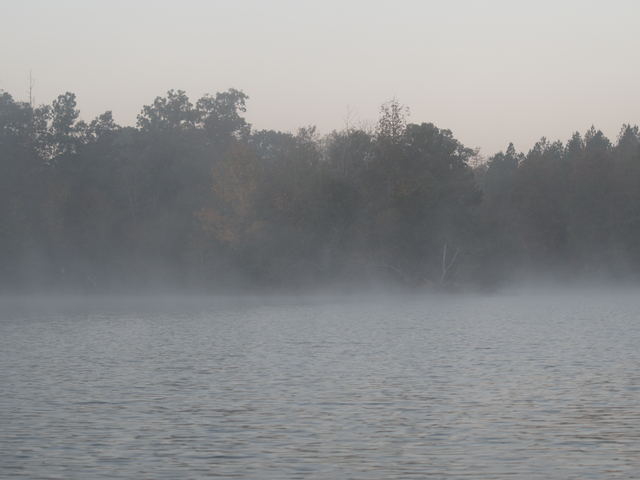

But once the sun starts to get up, the fog begins to dissipates and the sunlight makes the early fall colors stand out.

From the birds-eye view (if the bird is flying really high) the sun can make for some contrasting scenes and, combined with the wind, patterns on the water far below.

Now, back to the less-than-planet-sized creatures. I saw this large bird and grabbed the camera. I thought he was an Osprey, just because of the silhouette, size, and location, but I realized I was mistaken when I saw the photos.

Yes, that was the Bald Eagle. A bit later I found the Osprey, cavorting around the eastern side of the lake.


Have I mentioned how hard it is to get a good picture of a Kingfisher in action?

Nope, no Heron pictures this time. I saw a couple around, but maybe it was a bit early in the morning for them.
As usual, you can click on the pictures to get to a full-res version. I had to change photo sites because of problems with the previous one. Older pictures are still there, but henceforth anything new will probably end up on the new site.
Creature Feature 2016 #4
So much of our universe runs in cycles.
Some cycles are very artificial, of our own making. Like the workweek/weekend cycle, or election cycles (and that’s all I’ll say on that topic).
Some of these cycles are so short that we hardly notice. Like the day/night cycle. It happens every day, and we take it for granted.

Some cycles aren’t so regular. It rains, then the sun comes out, until it rains again, etc…

The lunar cycle is a bit longer, although if you’re not out much at night you might not notice. The tail end of a full moon is visible in the morning daylight.

Some cycles are so long that we might not even notice that there is a cycle going on. Haley’s Comet comes around every 75 or so years, making it a once-in-a-lifetime event, but still it’s a cycle. Clouds of gases collapse to form a star, that burns for a while, explodes into a cloud, that collapses… A cycle that probably no one is going to see in it’s entirety.
This time of year the season cycle is very much in evidence. The lake is noticeably quieter now as the resident residents prepare for the winter, and the transient residents begin to migrate to their winter homes.

With all that going on, there’s still plenty to see out on the lake. Like this Kingfisher:

or this Killdeer caught in flight:

This time of year is when I see Egrets around the lake (another cycle). This one had just made a short hop of a flight. Almost sort of a literal “puddle jumper”.

As I was paddling up the lake, I saw a large bird coming towards me. I grabbed the camera and just held the shutter button. I wasn’t sure at the time, but the pictures confirm that this was a bird that I’ve only seen a few times over the years.

Yes, that’s a Bald Eagle.

Gotta throw in a gratuitous Great Blue Heron picture:

Creature Feature 2016 #3
It’s interesting how all the divisiveness among humans contrasts with what goes on in the rest of the world. Sure, there’s competition and predation, but it’s all based on the needs of survival, and nothing more. Nobody is going at each other’s throats or calling each other names just because of an abstract concept, like the color of their plumage.
This Great Blue Heron was just strolling through a whole flock of vultures like it was no big deal, because it wasn’t:

Granted, these two species are very different and their needs don’t really overlap. On the other hand, this Egret and Heron do very much compete, and here they are within a couple wing-beats of each other:
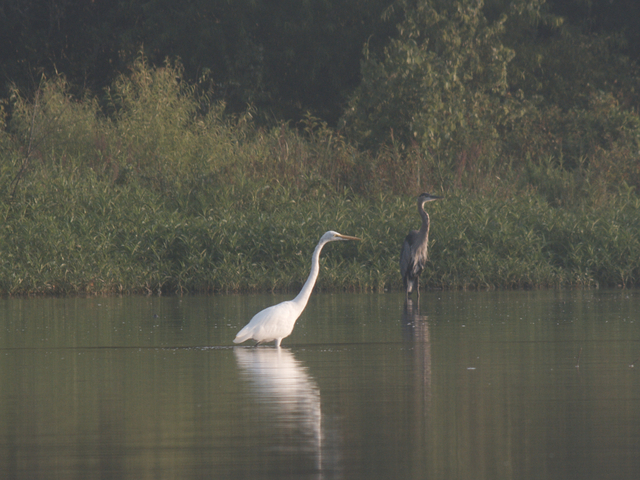
Obligatory Heron action shot; that’s a lot of bird to land up in a tree, but the extreme control they have makes it look easy:

And, from the clouds-as-creatures department, here’s some of those:

Creature Feature 2016 #2
I know, where have I been? I’ve had a lot going on, a lot of which could be the subject of a Caregiving Thoughts post. But, finally, I have some creature material (as usual, click on a picture to get to a higher-resolution version).
The first creature featured is a Beaver, but unfortunately, I didn’t get the camera pointed before he splashed the water and disappeared.

The Osprey were much more visible at their nest on top of the water system’s intake structure. I’m guessing these two are the parents, and they seemed quite intent on what was in the nest.
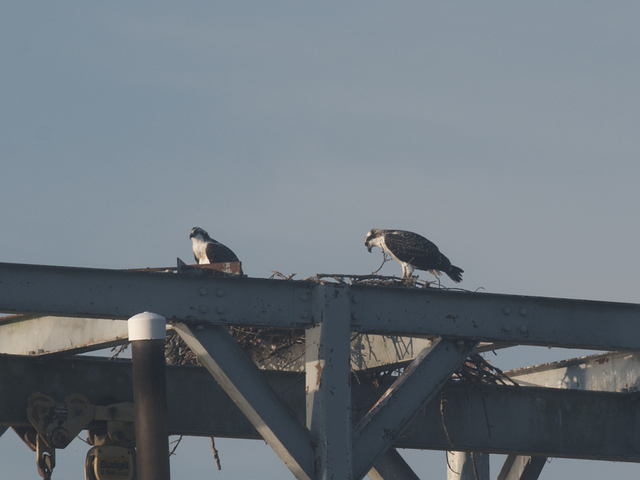
A third Osprey was hanging out on the other end of the structure, keeping an eye on me. Perhaps he’s a family member helping out?

Now, ordinarily, I wouldn’t think much of encountering a spider web, but this one was on some old tree branches sticking out of the water a good 6 or 7 meters from the nearest shore. Can spiders swim? Or maybe she just ballooned out there and set up shop. Given the insects caught in the web, I’d say, so far, so good.

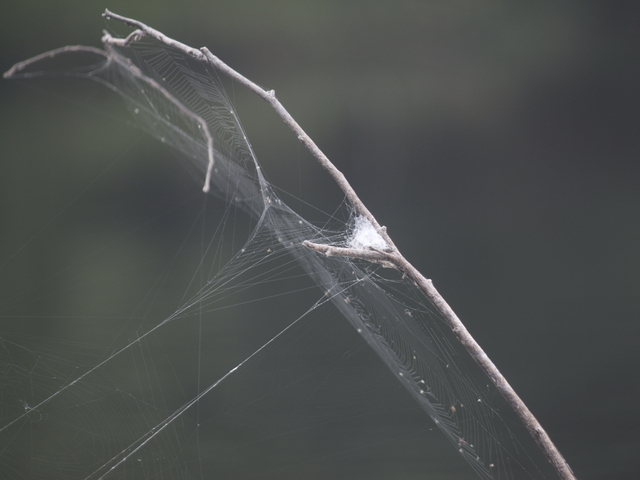
Of course, the obligatory Great Blue Heron picture. I got a lot of pixels on this one….

…just before he decided to take off and go to warp.

In another encounter, while out cycling, I crossed paths with a little Mockingbird, probably not much older than a fledgling. She was small and more stubby-looking than the normally slender adults, but the wing markings left no question that this was a Mockingbird.
In an encounter of a different kind, while we don’t think of clouds as creatures, the way the move, shift, grow, and change they can seem alive. Taken from high above Laurens County:

Creature Feature 2016 #1
Finally, I had a chance to get out on the lake. It was a foggy morning.

During the winter I noticed that the osprey nest on top of the water system’s intake structure was gone, perhaps due to stormy weather. They’ve rebuilt and are back.

This beaver was swimming back and forth, seeming to keep an eye on me.

One of the ways these critters communicate is by slapping the water with their tails. Wait for it…

It makes a really loud noise when they do this. It sounds a lot like someone dropped a bowling ball (and I don’t mean candlepin bowling) in the water.

Connections, Creation
The other day I was hanging out with a friend and there was a Christian radio station playing. The music was good, but the stations tag line, something like “Music that makes you feel connected to God”, made me think. For me, it’s not so much music, but views like this (near Sugarloaf Mountain, NC, USA):

or this (mini creature feature, over Lake Hartwell, SC, USA):

that does it. This, to me, represents the direct handiwork of God, no translations, no interpretations, just the straight story of Creation.
As usual, click on the pictures for full-resolution versions.
